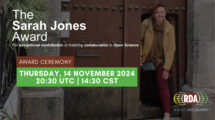If you attended the EOSC symposium in September in Madrid, you will know that almost all plenary conversations, at one moment or other, commented about the top-down vs bottom-up conundrum. What is meant here is that the EOSC Partnership is seen to a large extent by the community as a top-down arrangement, while the EOSC Association is the bottom-up community collaboration. Every so often during the conference, there was a moment when it became clear that the bottom-up activities, say around the EOSC working groups, did not have full alignment with the activities in the Steering Board or Partnership for EOSC. The top-down and the bottom-up rarely meet. But I don’t want to go into the questions around EOSC here as this is neither the place to do so, nor would that be helpful. I am merely using the example, as it led me to consider what these bottom-up/top-down scenarios mean for GÉANT and the NREN community.
At GÉANT and across the NREN community, we generally see ourselves as bottom-up organisations created either at the very beginning of the Internet around the respective “parent of the Internet” in a given country (some NRENs are celebrating 40 years of existence this year) or they were created a bit later to meet the community needs – much like DANTE and TERENA being created in the early 90s. Today, as then, the respective membership represents and defines the works and services in a very consensus driven model. So, we perceive ourselves as bottom-up and NRENs across the world have mainly been created bottom-up often in a green-field around a pioneer or champion or (if lucky) a team of champions.
How do you validate a bottom-up organisation?
So, then the question is: what is the way for bottom-up validation? Who actually decides that the organisation fulfils the needs of the research and education ecosystem? Maybe there are several answers, but I would stipulate that it is reliable service delivery that makes or breaks the validation of a bottom-up organisation: the national capillarity of the NREN backbone, the European and global footprint of the GÉANT network, the fact that we don’t reach capacity saturation levels, 6.4 billion eduroam authentications every year, 27 million eduGAIN users in the European R&E community, there are many more examples – this is our bottom-up validation. And while we are absolutely reliable, this holds.
More than just reliable service delivery: top-down validation needed too
The above is also the reason why the bottom-up community resents at times being questioned by top-down approaches on the validation for our organisations. We feel we have a right not to be questioned too much – we deliver every day, have done so for over 30 years at least, and deliver what is needed. What else do you want? Precisely. This is where a colleague from the German R&E community took what was to me a rather surprising stance (call me naïve): they said, “All very good, Cathrin, but nobody believes that whatever happened 30 or 40 years ago is today repeatable. The framework conditions are different, any bottom-up organisation today can no longer claim being in the green-field or a champion, you need top-down validation in addition to your reliable service delivery.” Very true. Sometimes the obvious just has to sneak up on you. I remembered that at the beginning of RedCLARA, Latin American NRENs had to bring “letters of endorsement” from their respective ministries, and I look around the world and see that NRENs struggle when they have no means of top-down validation or, at worst, are actively undermined from the top.
Successfully meeting in the middle – understanding both views
I think that the meeting in the middle part, at least for GÉANT, happens over the lifetime of the projects that we carry out: our project proposals are evaluated by external experts, we have regular reviews for the project activity, and thanks to an amazing project team full of NREN experts and our project office, we generally do extremely well in these reviews. And then of course we also meet in the middle when we undergo the project audits and general audits – and we have more than 15 of those in any given year. Again, we do very well, thanks to a sophisticated Finance team. But the full top-down validation only happens every so often. You may remember that I wrote on the “Fit for 2028” plans in CONNECT43 – where I talked about the need for GÉANT to be pillar assessed and become compliant to some ISO standards, meaning we are ready and strive for top-down validation right now (even if I – though writing about it and planning for it – didn’t fully understand the dynamics of it all).
So, here’s where the extra communication is needed, I think: when we do meet in the middle and when we prepare for top-down validation, we need to ensure that our funding bodies, the ministries or DGs looking after what we do, understand that we do have bottom-up validation. For that we need to ensure, particularly in an environment of e-infrastructures where services are generally invisible due to their federated nature, that we make our impact as visible and understandable as we can. Equally, we need to communicate closely to ensure that our customers and members from time to time understand that we need to deliver on broader policy goals and objectives without fearing the loss of the bottom-up influence.
The balance is in the middle, and organisations such as GÉANT need to meet the requirements of the bottom-up – absolutely reliable services with continuity – and the top-down – allowing for a level of vision and oversight, including trends, changing politics, and policies.
We are facilitating the middle part in this conversation and that role needs to be understood, because the top-down cannot manage and deliver the services but should provide vision, and should enable, and therefore needs to be interested that the bottom-up continues to flourish and perform.







